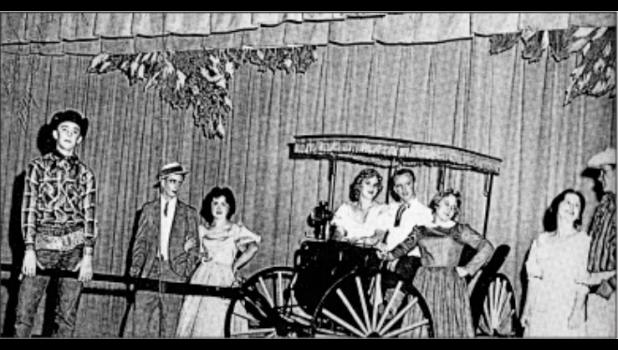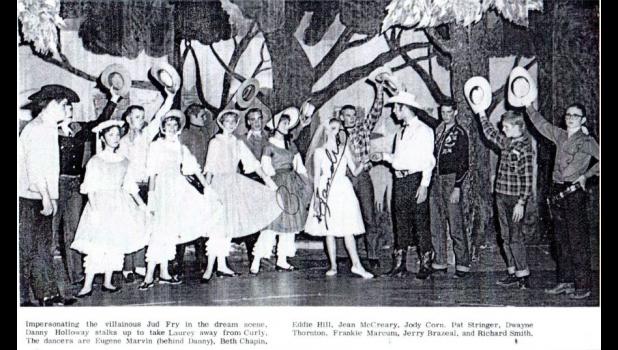Oklahoma . . . 59 Years Ago
Wed, 05/27/2020 - 10:50am
admin
By:
Lonnie Whitaker
Fifty-nine years ago, the curtain went up for the WSHS production of Rogers and Hammerstein’s Oklahoma. It was the first musical play in school history, and of my high school memories, it ranks near the top.
Oklahoma played to capacity crowds in the school auditorium November 16-17, 1961. Groups of observers came from Southwest Missouri State, Drury College, and surrounding towns.
The school yearbook, Willamizzou, devoted six full pages to the production that involved the combined efforts of the music, dramatics, and art departments, plus girls’ physical education classes.
The mixed chorus class, instead of learning madrigals or other unfamiliar songs, rehearsed the title song, “Oklahoma,” and other songs sung by the cast, including “The Surrey with the Fringe on Top,” “Many a New Day,” “Oh, What a Beautiful Morning,” and “Kansas City,” until pitch-perfect.
Under the supervision of art teacher Marie Booth, serving as sets and lighting director, art students wielded hammers, saws, and paint brushes to design and construct the stage sets, and later, behind the curtains, managed the scene changes during the performances.
Girls’ physical education classes took a break from exercising with Indian clubs (wooden, bowling pin-looking-clubs) to practice dance routines for Oklahoma, under the direction of teacher Wilma Stringer. In the role of choreographer, Mrs. Stringer even managed to transform male cast members into formidable hoofers, combining a few steps from the Charleston with square dancing moves.
Junior Mary Nell Ladage and senior David Barnes headlined the show portraying sweethearts, Laurey and Curly. Mary Nell, the pretty Hoop Queen candidate and Bruin Band majorette, and David, the handsome athlete with curly hair and a resonant singing voice—he won first place in the state music competition—projected convincing on-stage chemistry.
Supporting actors, senior Janice Zimmerman and sophomore Bill Tandy, generated laughs playing mixed-up lovers, Ado Annie and Will Parker. Senior Gail McAllister wowed the crowds with her portrayal of the wise-cracking Aunt Eller. Sophomore Fred Corl nailed the part of Ali Hakim, the Persian peddler man, forsaking Ado Annie in favor of Gertie Cummings, played by senior Nancy Cowger, to avoid a “shotgun” wedding. And sophomore Sandra Davidson and senior Bill Haas tripped the light fantastic in the magical dream scene.
Bill Tandy recalls a scene that called for him to kiss a girl, but he was hesitant to do so because his good friend had a crush on the girl. When the time for the kiss arrived, he removed his cowboy hat and shielded their faces giving the appearance to the audience they were kissing. “I still regret not kissing her,” Tandy said.
Junior Ron Frost played the villainous Jud Fry to perfection, with one slight problem—his singing voice was not equal to his thespian talents—and this was a musical. Music Director Carl Walker and the Art Department solved the problem.
For the famous bunkhouse scene, where Jud tries to frighten Curly, the set walls representing the inside of the bunkhouse, were painted to resemble rough-sawn boards, with a strategically placed knothole, a tad larger than a golf ball, about head high. During the performance, Mr. Walker hid behind the set and sang the words to “Poor Jud is Dead” through the knothole, while Ron pantomimed the words.
Although the main character parts had been previously selected in the spring semester, plenty of opportunities still existed for my freshman class in the fall. Sandy and Sharon Merrill, Peggy Henry, and Sandy Flake, became tutu-wearing dancehall girls behind the footlights. Eddie Mack Hill, Jody Corn, Jerry Brazeal, Richard Smith, and I donned borrowed cowboy boots and hats and strapped on shootin’ irons and tried to keep pace with the girls’ more graceful dancing moves.
Other classmates participated in offstage jobs. Doug James, Jim Thomas, the Zimmerman twins, and Barbara Graves worked the box office and served as ushers.
The arrival of music teacher Carl Walker and dramatics/speech teacher Raimon Newby, within a year of each other, marked a fundamental change in dramatic arts at WSHS. Previously, the school had presented stage plays, but never a Broadway musical. And these two teachers had the chops to pull it off.
Both were musicians. Of course, you would expect that of Mr. Walker, with a Masters in Music Education from the University of Missouri, but he had also been a member of the select Mizzou University Singers.
As for Mr. Newby, he was no slouch as a singer. He earned extra money in college singing in a barbershop quartet, which actually made a record album. While in high school, I listened to the record, and it was good. Showing another example of his ability, he sang at the wedding of Barbara Sherrill and Dick Pigg (both, WSHS ’64).
Together, the Walker/Newby collaboration paved the way for several musicals in the 1960s: South Pacific, Carousel, and Annie Get Your Gun. Deanna Collins (WSHS ’64), a member of the Oklahoma cast, and who had the lead role in South Pacific, recently shared her memory of Oklahoma, “What a fun musical! Mr. Newby was a gifted director.”
Trying to capture the smell of the greasepaint and roar of the crowd; the anticipation of opening night; the comradery of late school-night rehearsals; and the aura of excitement that existed in the school and town, is a hard task. Feelings and emotions are like that. But as to the memory of it all, Deanna Collins captured it nicely, “Those were wonderful, carefree days growing up in a safe community.” And that’s the way we were in the fall of 1961.



